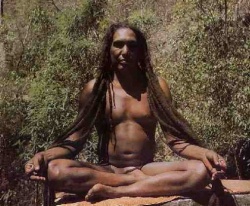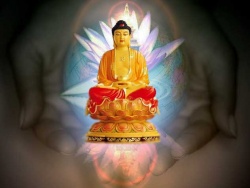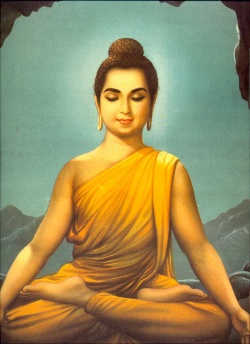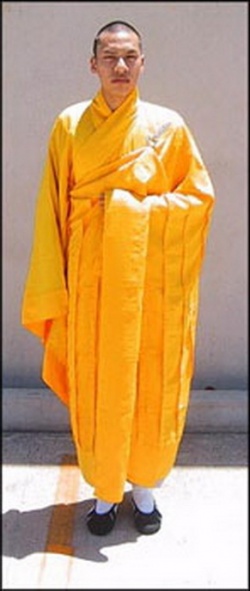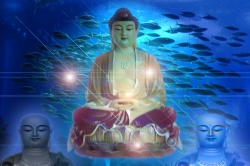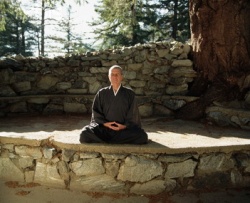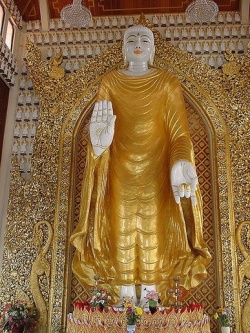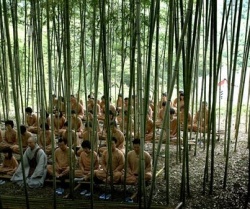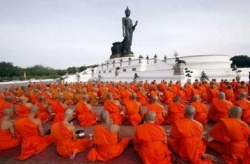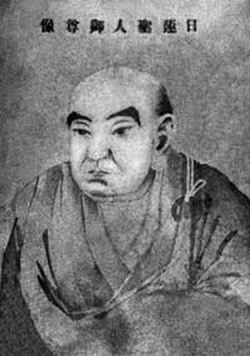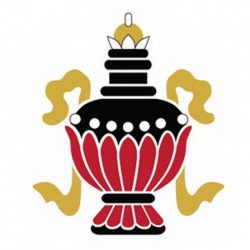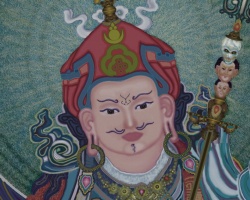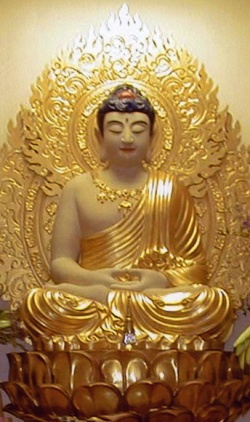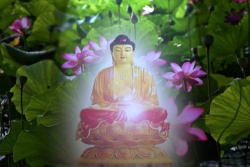Difference between revisions of "Chinese bhikshuni ordination"
(Created page with " A brief exploration and guidelines for consulting other vinaya schools (for oral presentation) Venerable Bhikshu Ben Yin is Vice-President of Nanputuo Bu...") |
|||
| Line 1: | Line 1: | ||
| + | <nomobile>{{DisplayImages|1095|1017|4042|700|2533|4158|723|2260|2199|2189|2768|3541|3060|2075|4143|831|3486}}</nomobile> | ||
| Line 8: | Line 9: | ||
I. {{Wiki|Chinese}} [[Vinaya Lineage]] and the Spread of the [[Dharmaguptaka Vinaya]] | I. {{Wiki|Chinese}} [[Vinaya Lineage]] and the Spread of the [[Dharmaguptaka Vinaya]] | ||
| − | The [[Buddha’s]] {{Wiki|purpose}} of establishing [[precepts]] is to regulate the [[monastic]] [[sangha]] so that the three poisons—ignorance, [[attachment]], and anger—will be uprooted and the [[Dharma]] will be forever sustained in the [[world]] | + | The [[Buddha’s]] {{Wiki|purpose}} of establishing [[precepts]] is to regulate the [[monastic]] [[sangha]] so that the three poisons—ignorance, [[attachment]], and anger—will be uprooted and the [[Dharma]] will be forever sustained in the [[world]]. |
| − | + | After the [[Buddha’s]] [[parinirvana]], the [[Buddhist community]] split into various sects. [[Buddhism]] was transmitted into [[China]], and the first [[bhikshu]] appears in the [[Cao-Wei Dynasty]] during the Jia Ping years of 249-253 AD. | |
| − | + | [[Bhikshu]] [[Dharmakala]] translated the [[Pratimoksa]] of [[Sāṅghikā-vinaya]].1 | |
| − | |||
| − | + | Meanwhile, during the {{Wiki|era}} of [[Zheng]] Yuan, 254-255 AD, [[Bhikshu]] [[Tandi]], from {{Wiki|Parthia}} (today’s {{Wiki|Iran}}), came to the [[Baima Temple]] in [[Luoyang]] where he translated the [[ordination]] [[sanghakarma]] of the [[Dharmaguptaka school]]. | |
| − | + | Furthermore, ([[bhikshu]]) [[ordinations]] starting with [[Zhu Shi-xing]] and others began. | |
| − | + | The [[bhikshu ordination]] continues till today in the {{Wiki|Chinese}} {{Wiki|community}}. | |
| − | [[ | + | The [[bhikshuni sangha]] in [[China]] began with [[Bhikshuni]] [[Jing-Jian]] who resided in [[Zhu Lin Temple]] in [[Luoyang]]. |
| − | The [[dual sangha ordination]] [[lineage]] in [[China]] began in the 11th year of the [[Yong Jia]] {{Wiki|era}}, 434 AD, in the Liu-Song | + | She first received [[ten precepts]] from [[Bhikshu]] [[Zhishan]] who was from [[western]] [[China]]. |
| + | |||
| + | In the first year of the Sheng Ping {{Wiki|era}}, 357 AD, in the Eastern [[wikipedia:Jin Dynasty (265-420)|Jin Dynasty]], a foreign [[bhikshu]] named [[Tan Mo Jie Duo]] gave the [[bhikshuni ordination]] to [[Jing-Jian]] and other women. | ||
| + | |||
| + | Since there were no foreign [[bhikshunis]] in [[China]] at that time, the [[ordination]] was given by the [[bhikshu sangha]] alone (single [[sangha]] [[ordination]]). | ||
| + | |||
| + | The first [[dual sangha ordination]] in which both [[bhikshus]] and [[bhikshunis]] participated took place in the 11th year of the [[Yong Jia]] {{Wiki|era}}, 434 AD, in the [[Liu-Song Dynasty]], with [[Indian]] [[Bhikshu]] [[Sanghavarman]] and [[Sri Lankan]] [[Bhikshuni]] [[Devasara]] and her [[colleagues]] granting the [[ordination]]. | ||
| + | |||
| + | The [[ordination platform]] was located in [[Nanlin Temple]]. Ven. [[Huiguo]], Ven. [[Jing-Yin]], and three hundred others were fully re-ordained.2 | ||
| + | |||
| + | After 250 AD, during the [[Dynasty]] of the [[Three Kingdoms]], various schools of [[Vinaya]] came to [[China]] at about the same time. The translation of the texts of the four major [[Vinaya]] schools along with the five [[Vinaya]] commentaries were completed. | ||
| + | |||
| + | At first, the [[Sarvastivada Vinaya]] and [[Mahasanghika Vinaya]] were practiced and circulated, but only one school succeeded in becoming a living [[lineage]] over time; that was the [[Dharmaguptaka School]], which was promoted by [[Vinaya Master]] Daoxuan4 and became known as the [[Nanshan Vinaya School]]. | ||
| + | |||
| + | 5 From that time onwards until today, without interruption, the [[Dharmaguptaka]] [[ordination]] procedure has been used and the [[Dharmaguptaka Vinaya]] has been followed. [[Vinaya Master]] [[Daoxuan]] used the [[Dharmaguptaka Vinaya]] as the base, checking it against all other schools. | ||
| + | |||
| + | He cited references extensively, combined the [[Mahayana]] [[motivation]] with the practice of keeping [[Pratimoksa]] [[precepts]], and developed a structured approach to [[Vinaya]] study which involves {{Wiki|examination}} of the four aspects of the [[precepts]]: | ||
| + | |||
| + | |||
| + | <poem> | ||
| + | 1) the [[precepts]] of the [[Dharma]], | ||
| + | 2) the [[precept]] [[body]], | ||
| + | 3) precepts-in-action, and | ||
| + | 4) the [[characteristics]] of [[precepts]]. | ||
| + | </poem> | ||
| + | |||
| + | Being an authoritative guide to the {{Wiki|Chinese}} [[lineage]], he made a tremendous contribution to the [[Vinaya School]] in [[China]]. | ||
| + | |||
| + | |||
| + | |||
| + | II. The [[Ordination of Bhikshunis]] | ||
| + | |||
| + | |||
| + | |||
| + | Regarding the [[ordination]] of [[bhikshunis]], [[Vinaya Master]] [[Daoxuan]] says in [[Jie Mo Shu]], “In the {{Wiki|past}}, the [[Mahīśāsaka Vinaya]] was used. It says that ten [[bhikshus]] and one [[bhikshuni]] are needed for [[ordination]].” | ||
| + | |||
| + | ([[Taisho]] v22, p186a) A single [[sangha]] [[ordination]] also appears in our [[Dharmaguptaka tradition]]. | ||
| + | |||
| + | What is the source that supports such practice? Ven. [[Bhikshu]] [[Gunavarman]],6 says, “The candidates receive the [[ordination]], but the ordaining [[sangha]] commit a {{Wiki|transgression}}. | ||
| + | |||
| + | Since in the [[bhikshuni ordination]] the [[precept]] [[body]] is formally generated while the [[karma]] is being performed in front of the [[bhikshu sangha]], even though (the candidates) have not been first certified by the [[bhikshuni sangha]], the [[ordination]] is not hindered by that. | ||
| + | |||
| + | It is just like (the [[ordination]] of the first [[bhikshuni]]) [[Bhikshuni]] [[Mahāprajāpatī]] (who later was the [[upadhyayika]] along with ten other [[bhikshus]] who) [[ordained]] [[bhikshunis]].” | ||
| + | |||
| + | [[Vinaya Master]] [[Daoxuan]] agrees with Ven. [[Gunavarman]] ([[Xu Tsang Jing]] v41,p284b), and he further confirms, “The [[single sangha ordination]] with only the [[bhikshu sangha]] is still valid,” | ||
| + | |||
| + | because there is no statement in the [[Vinaya]] that clearly says the [[ordination]] is invalid if the candidates are [[ordained]] only by a single [[sangha]] without being first certified by the [[bhikshuni sangha]]. | ||
| + | |||
| + | If there were such a statement in the [[Vinaya]] that invalidates [[ordination]] by a single [[sangha]], then since the practice of dual [[sangha]] has not been continuous, | ||
| + | |||
| + | the [[lineage]] of [[bhikshuni ordination]] in [[China]] would have been discontinued. | ||
| + | |||
| + | There would be no one in [[China]] who could give the [[bhikshuni ordination]], and we would have to again invite foreign [[bhikshunis]] for assistance. | ||
| + | |||
| + | Saying that the single [[sangha]] [[ordination]] is invalid is disputable. | ||
| + | |||
| + | If there were a [[Vinaya]] statement saying that the [[ordination]] by a single [[sangha]] is valid, that would settle the issue. | ||
| + | |||
| + | However, since there was not an incident in the [[Buddha’s]] time that necessitated such a {{Wiki|rule}}, there is no {{Wiki|rule}} that directly indicates a valid [[ordination]] is obtained by a single [[sangha]]. | ||
| + | |||
| + | Furthermore, it is regulated that [[nuns]] should be [[fully ordained]] by the dual [[sangha]]. | ||
| + | |||
| + | Therefore, it is impossible to have a [[precept]] that says the opposite. | ||
| + | |||
| + | On the contrary, the [[Vinaya]] indicates that a {{Wiki|transgression}} is committed if this requirement is not followed. What exact {{Wiki|transgression}} is committed if this {{Wiki|rule}} is not kept? | ||
| + | |||
| + | Changing a [[dual sangha ordination]] into a single [[sangha]] [[ordination]] is a situation in which the number of [[people]] required in the [[karma]] procedure is insufficient. | ||
| + | |||
| + | The situation of single [[sangha]] [[bhikshuni ordination]] is similar to, but not exactly the same as the [[ordination]] of [[bhikshus]] with an insufficient number of [[monks]] in the [[bhikshu sangha]]. | ||
| + | |||
| + | The meaning is related based on the fact that [[bhikshu]] candidates can receive their [[ordination]] despite the fact that the [[bhikshu sangha]] didn’t adhere to the requirement. | ||
| + | |||
| + | It is reasonable to apply the situation of a [[bhikshu ordination]] given with insufficient [[monks]] to the situation of a [[bhikshuni ordination]] given with insufficient [[bhikshunis]] because when the [[Buddha]] established a [[precept]] and its various degrees of {{Wiki|transgression}} for [[bhikshus]], it was usually applied to [[bhikshunis]] too.7 | ||
| + | |||
| + | [[Vinaya Master]] [[Daoxuan]] said that it is acceptable to adopt an explanation from another [[Vinaya school]] if nothing on that particular topic can be found in our school. Let us apply this to the issue of [[bhikshuni ordination]]. | ||
| + | |||
| + | In the [[Sarvastivada Vinaya]], volume 55, ([[Taisho]] v23, p405a), it says, “Ten [[bhikshus]] live in a remote area but only [[five bhikshus]] are {{Wiki|present}} in the [[ordination]]. | ||
| + | |||
| + | Does the candidate receive the [[precepts]]? Yes, he receives the [[precepts]] but the ordaining [[sangha]] commits a {{Wiki|transgression}}.” | ||
| + | |||
| + | In the [[Mulasarvastivada Vinaya]], volume 13, ([[Taisho]] v24, p597c), it says, “In a remote area where it is possible to find ten [[monks]], only five are {{Wiki|present}} at an [[ordination]]. The candidates are [[fully ordained]], but the [[sangha]] commits a {{Wiki|transgression}}.” | ||
| + | |||
| + | According to the [[bhikshu]] {{Wiki|rules}}, ten [[bhikshus]] are needed to perform an [[ordination]] [[karma]]. | ||
| + | |||
| + | If this rule—having sufficient number of participants—is violated, judging from the [[Sarvastivada Vinaya]] and the [[Mulasarvastivada Vinaya]], the conclusion is that the candidates still receive the [[precepts]], but the [[preceptor]] commits a {{Wiki|transgression}}. | ||
| + | |||
| + | Similarly, when the rule—dual [[sangha]] [[bhikshuni]] ordination—is violated, although it is against the [[Buddha’s]] instruction, its result should be similar to the case of insufficient [[monks]] in a [[bhikshu ordination]]. | ||
| + | |||
| + | That is, the [[bhikshuni]] candidates receive the [[precepts]], but the ordaining [[sangha]] commits a {{Wiki|transgression}}. | ||
| + | |||
| + | This proves that the inferences made by [[Gunavarman]] and [[Vinaya Master]] [[Daoxuan]] are without fault. | ||
| + | |||
| + | The [[dual sangha ordination]] [[lineage]] in [[China]] began in the 11th year of the [[Yong Jia]] {{Wiki|era}}, 434 AD, in the [[Liu-Song Dynasty]]. | ||
| + | |||
| + | However, in the fifth year of the [[Kai]] Bao {{Wiki|era}}, 972 AD, it was stopped by [[Emperor]] [[Taizu]] of the [[Northern]] {{Wiki|Song Dynasty}}. | ||
| + | |||
| + | The ban was lifted in the [[Wikipedia:Song Dynasty|Southern Song Dynasty]] during the {{Wiki|era}} of {{Wiki|Xian}} Chun, 1265-1274 AD ([[Taisho]] v49, p396b). Thus the ban was in effect for about three hundred years. | ||
| + | |||
| + | However, other historical materials from that time record that [[bhikshus]] openly recruited [[nuns]] to receive the [[dual sangha ordination]] (The Four [[Books]], Zih Bu Za Jia Lei p.31). | ||
| + | |||
| + | Nevertheless, because [[China]] is a huge country, it is hard to say whether a record [[exists]] somewhere that proves the uninterrupted [[existence]] of the [[dual sangha ordination]]. | ||
| + | |||
| + | In the {{Wiki|Ming Dynasty}}, {{Wiki|Qing Dynasty}} and even the {{Wiki|modern}} {{Wiki|era}}, [[ordination]] with a single [[sangha]] was commonly seen. To avoid being labeled as someone who just looks like a [[bhikshuni]], many [[nuns]] seek [[ordination]] by a dual [[sangha]]. | ||
| + | |||
| + | In short, while the history of the [[dual sangha ordination]] has occasionally been interrupted, [[bhikshuni ordination]] in [[Chinese Buddhism]] has continued to this day. | ||
| + | |||
| + | Clearly, the [[ordination]] was given based on the [[reason]] that candidates receive the [[precepts]] in a [[single sangha ordination]]. | ||
III. Guidelines for Consulting Other [[Vinaya]] Schools | III. Guidelines for Consulting Other [[Vinaya]] Schools | ||
| − | Questions have been asked to {{Wiki|Chinese}} [[Buddhist monastics]] about [[Vinaya]] issues regarding [[bhikshuni ordination]]. When focus is put on the [[ordination]] procedure, since each [[Vinaya school]] has its [[own]] view on what is important and what is not, what can be adopted and what cannot, how can we determine whether one particular procedure is legal or not? Also, for the {{Wiki|purpose}} of practice, what can we do in terms of adopting [[ideas]] from other schools? [[Vinaya Master]] [[Daoxuan]] has set a guideline: When a particular [[Vinaya school]] is used for the [[ordination]] procedure, we should rely on this [[Vinaya school]] in determining the issue of the ordination’s legality. However, if the texts of this particular school are not clear on particular points, for the {{Wiki|purpose}} of practice we should adopt explanations from other schools ([[Taisho]] v 40, p2-3). | + | Questions have been asked to {{Wiki|Chinese}} [[Buddhist monastics]] about [[Vinaya]] issues regarding [[bhikshuni ordination]]. |
| + | |||
| + | When focus is put on the [[ordination]] procedure, since each [[Vinaya school]] has its [[own]] view on what is important and what is not, what can be adopted and what cannot, how can we determine whether one particular procedure is legal or not? | ||
| + | |||
| + | Also, for the {{Wiki|purpose}} of practice, what can we do in terms of adopting [[ideas]] from other schools? [[Vinaya Master]] [[Daoxuan]] has set a guideline: | ||
| + | |||
| + | When a particular [[Vinaya school]] is used for the [[ordination]] procedure, we should rely on this [[Vinaya school]] in determining the issue of the ordination’s legality. | ||
| + | |||
| + | However, if the texts of this particular school are not clear on particular points, for the {{Wiki|purpose}} of practice we should adopt explanations from other schools ([[Taisho]] v 40, p2-3). | ||
| + | |||
| + | The fundamental [[logic]] for the guidelines for following explanations found in other [[Vinaya]] Schools is as follows. | ||
| + | |||
| + | After the [[Buddhist community]] split into various sects, each [[sect]] has its [[own]] set of priorities and each of them provides guidance on how to practice, which, in turn, leads to the final [[liberation]]. | ||
| + | |||
| + | It is like a big map torn into pieces: the followers of each [[sect]] possess one portion which describes the [[direction]] toward the destination. Some of the routes are shared by all sects, some are not. | ||
| + | |||
| + | When we come to a point and encounter a certain situation, some portions of the map describe the situation while others do not. | ||
| + | |||
| + | Since one portion of the map does not include all the details, if we only consult it the problem cannot be solved. | ||
| + | |||
| + | To determine which [[direction]] to take, we have to consult other portions of the map. As stated in [[Mahisasaka Vinaya]], “Although something is regulated by my school, if all other schools deem it impure, it should not be adopted. | ||
| + | |||
| + | If something is not regulated by my school and all other schools say it is to be practiced, I must also adopt it.” Based upon this [[thinking]], the guidelines for consulting other [[Vinaya]] schools can be determined. There are two main points in doing this. | ||
| + | |||
| + | 1. The {{Wiki|purpose}} of all the [[Vinayas]] is the same because they all originated from the same source—the [[Buddha]]. | ||
| + | |||
| + | Since [[sentient beings]]’ dispositions have been influenced by their backgrounds and what they have learned, their [[understanding]] of the meaning varies so much that divisions among them occur. | ||
| + | |||
| + | Although one [[sect]] may differ from another in terms of the [[doctrines]] and practices, the goal that they want to achieve—nirvana—remains the same. It is just like a golden stick that has been broken into pieces: each piece is still {{Wiki|gold}}. | ||
| + | |||
| + | Following the practices prescribed in each school, one will definitely [[benefit]]. ([[Taisho]] v41, p813c) | ||
| + | |||
| + | |||
| + | 2. To set up a standard that remains consistent within a school: | ||
| + | |||
| + | (1) Regarding determining what to observe and what constitutes a {{Wiki|transgression}}, generally {{Wiki|speaking}}, if the sanghakarma of a certain school is used for [[ordination]], the [[Vinaya]] of that school should also be used to determine the different degrees of observation or {{Wiki|transgression}} of the [[precepts]]. | ||
| + | |||
| + | That is, one’s [[actions]] and practices should correspond with the [[precept]] [[body]] that one has received. | ||
| + | |||
| + | For instance, when performing [[ordination]], the {{Wiki|Chinese}} [[Buddhist community]] uses the sanghakarma of the [[Dharmaguptaka Vinaya]]. | ||
| + | |||
| + | So the [[Dharmaguptaka Vinaya]] should be the primary reference for {{Wiki|learning}} the [[characteristics]] of each [[precept]] and putting them into [[action]]. | ||
| + | |||
| + | To determine whether a {{Wiki|transgression}} has been made within our [[own]] school, we should not use the [[Vinaya]] of other schools. | ||
| + | |||
| + | By the same token, we should not use the [[Vinaya]] of our [[own]] school to criticize other schools or to say their procedures are illegal because each school has its [[own]] detailed explanations. (2) However, there are some exceptions. | ||
| + | |||
| + | If (a) one’s [[own]] [[Vinaya]] is not clear or (b) an incident happens, but no clear explanation related to it can be found within one’s [[own]] school, it is permissible to use the [[Vinaya]] of other schools to make a [[decision]]; we can borrow [[ideas]] from other schools to supplement one’s [[own]]. | ||
| + | |||
| + | Nevertheless, since the way to conduct a sanghakarma is already prescribed in one’s [[own]] school, we should follow that instead of other schools. | ||
| + | |||
| + | According to [[Vinaya Master]] [[Daoxuan]], asking [[monastics]] from other [[Vinaya]] schools to assist in an [[ordination]] or following [[Vinaya]] explanations of other schools should be done only if they cannot be found in one’s [[own]] school. | ||
| + | |||
| + | If a group of [[monastics]] agree to invite [[monastics]] from another school or use the explanations of another school to supplement their [[own]], they should not later criticize the other school or regard it as not being in line with the {{Wiki|rules}}. | ||
| + | |||
| + | The [[Vinaya]] commentary Xing Shi Chao8 ([[Taisho]] v40, p155b) gives two examples: according to the [[Sarvastivada Vinaya]] and [[Shan Jian]] 9 if there is no [[preceptor]] ([[Upadhyaya]]) for a [[bhikshu ordination]], ' | ||
| + | |||
| + | the candidate still receives [[ordination]], but the [[sangha]] commits a {{Wiki|transgression}}. | ||
| + | |||
| + | The Commentary of Mo De Le Qie says that if a [[layperson]] is the [[preceptor]], the candidate still receives the [[ordination]], but the [[sangha]] commits a {{Wiki|transgression}}. | ||
| + | |||
| + | Although other schools say the [[ordination]] is still valid, according to the [[Dharmaguptaka Vinaya]], if there is no [[preceptor]] present10 or if there are two or three preceptors, | ||
| + | |||
| + | the [[ordination]] is not valid. Also, in the [[Mahasanghika Vinaya]] and the [[Sarvastivada Vinaya]], the steps of a [[sanghakarma]] can be increased. | ||
| + | |||
| + | For example, if the original procedure involves only an announcement, it can be increased to one announcement followed by one proclamation, or one announcement followed by three proclamations. | ||
| − | + | However, the steps cannot be decreased. According to the [[Dharmaguptaka Vinaya]], [[sanghakarma]] procedures were established by the [[Buddha]], so any {{Wiki|decrease}} or increase to the procedure would make the [[ordination]] invalid. | |
| − | + | Judging from the above analysis, when foreign [[monastics]] come to transmit the [[ordination]], their {{Wiki|purpose}} is primarily to fulfill the function required by the [[Vinaya]]. | |
| − | + | The local [[Vinaya school]] should not invalidate the [[ordination]] based upon different [[views]] or standards held by the other school. | |
| − | + | For example, [[Theravada]] [[bhikshus]] or [[Tibetan]] [[bhikshus]] could go to a {{Wiki|Chinese}} [[temple]] and join the [[bhikshu sangha]] there in giving [[ordination]] without any problem. | |
| − | + | If they reside with the local [[sangha]], they should follow the [[Vinaya]] standard of {{Wiki|behavior}} of the local [[Vinaya school]]. If they reside on their [[own]], this is not necessary. | |
IV. Conclusion | IV. Conclusion | ||
| − | There is just one outcome from of a legal full ordination—the [[person]] is [[fully ordained]]. However, when putting the [[precepts]] into practice, different [[Vinaya]] schools may have different ways to describe the [[precept]] [[body]] or the [[characteristics]] of each [[precept]]. It is like there is simply one flow of [[water]] of [[Dharma]], but it enters into various [[rivers]] and streams. According to the [[channels]], different labels come to [[exist]]. Even though a [[monk]] is first [[ordained]] with the sanghakarma prescribed by the [[Dharmaguptaka Vinaya]], | + | There is just one outcome from of a legal full ordination—the [[person]] is [[fully ordained]]. |
| + | |||
| + | However, when putting the [[precepts]] into practice, different [[Vinaya]] schools may have different ways to describe the [[precept]] [[body]] or the [[characteristics]] of each [[precept]]. | ||
| + | |||
| + | It is like there is simply one flow of [[water]] of [[Dharma]], but it enters into various [[rivers]] and streams. | ||
| + | |||
| + | According to the [[channels]], different labels come to [[exist]]. Even though a [[monk]] is first [[ordained]] with the [[sanghakarma]] prescribed by the [[Dharmaguptaka Vinaya]], | ||
| − | + | there is no problem for him to be a well-behaved [[bhikshu]] if he happens to like the [[Sarvastivada Vinaya]] and puts it into practice.11 | |
| − | This paper has briefly introduced the history of the {{Wiki|Chinese}} [[Buddhist tradition]] and discussed the guidelines set by [[Vinaya Master]] [[Daoxuan]] when adopting explanations or inviting [[monastics]] for a sanghakarma from other [[Vinaya]] schools. I {{Wiki|hope}} that with these guidelines in [[mind]], we will know what to adopt and what to abandon without causing [[disputes]] among [[Vinaya]] schools. Since my fellow brothers and sisters in the [[Tibetan Buddhist]] {{Wiki|community}} are considering establishing a [[bhikshuni lineage]], it is my {{Wiki|hope}} that the points raised in this paper are helpful. Since the study was done within a limited time, I {{Wiki|fear}} that errors might have been made. Please extend your [[kindness]] and point them out to me. Thank you. | + | As long as he observes the [[precepts]] carefully, following the standard set by that school, he will receive the [[benefit]] of taming his [[defilements]]. |
| + | |||
| + | Doing this does not contradict the [[Buddha’s]] {{Wiki|purpose}} of establishing the [[precepts]]. | ||
| + | |||
| + | However, if a [[person]] picks [[ideas]] randomly from different schools and practices without any specific standard, then he is going against the [[Buddha’s]] {{Wiki|purpose}} of establishing the [[precepts]]. | ||
| + | |||
| + | This [[individual]] does not belong to any of the schools, and his [[actions]] should be seen as improper and illegal. | ||
| + | |||
| + | [[Vinaya Master]] [[Daoxuan]] is strongly against such type of practice. | ||
| + | |||
| + | Therefore, [[Vinaya Master]] [[Daoxuan]] set up guidelines regarding when to follow the explanations of other schools so that the [[lineage]] of one’s school as well as its [[sanghakarma]] are in accord with that school’s fundamental [[belief]] and the observation and {{Wiki|transgression}} of the [[precepts]] can be clearly {{Wiki|distinguished}} according to one’s school. | ||
| + | |||
| + | These guidelines enable practitioners to receive the [[precept]] [[body]] according to the [[Vinaya school]] whose [[ordination]] procedure is used and to act in accord with the [[precepts]] so that all their [[actions]] reveal the [[characteristics]] of the [[precepts]]. | ||
| + | |||
| + | They also ensure that members of one school will not criticize other schools or argue about who is right and who is wrong. In this way, all the various [[Vinaya]] schools can be harmonious, and the [[Dharma]] will not {{Wiki|decline}} in the [[world]]. | ||
| + | |||
| + | Together we will spread the {{Wiki|holy}} [[Dharma]]. This will be praised by all. | ||
| + | |||
| + | This paper has briefly introduced the history of the {{Wiki|Chinese}} [[Buddhist tradition]] and discussed the guidelines set by [[Vinaya Master]] [[Daoxuan]] when adopting explanations or inviting [[monastics]] for a sanghakarma from other [[Vinaya]] schools. | ||
| + | |||
| + | I {{Wiki|hope}} that with these guidelines in [[mind]], we will know what to adopt and what to abandon without causing [[disputes]] among [[Vinaya]] schools. | ||
| + | |||
| + | Since my fellow brothers and sisters in the [[Tibetan Buddhist]] {{Wiki|community}} are considering establishing a [[bhikshuni lineage]], it is my {{Wiki|hope}} that the points raised in this paper are helpful. | ||
| + | |||
| + | Since the study was done within a limited time, I {{Wiki|fear}} that errors might have been made. | ||
| + | |||
| + | Please extend your [[kindness]] and point them out to me. Thank you. | ||
<poem> | <poem> | ||
[[Dharmakala]] was also the first [[monk]] to give [[bhikshu ordination]] in [[China]] in the third century ↩ | [[Dharmakala]] was also the first [[monk]] to give [[bhikshu ordination]] in [[China]] in the third century ↩ | ||
| − | It is said that they were re-ordained because previously they had been [[ordained]] in a single [[sangha]] [[ordination]]. Subsequent to that, many [[bhikshunis]] arrived from [[Sri Lanka]], thus giving them the opportunity to receive [[bhikshuni ordination]] from a dual [[sangha]]. ↩ | + | It is said that they were re-ordained because previously they had been [[ordained]] in a single [[sangha]] [[ordination]]. |
| + | |||
| + | Subsequent to that, many [[bhikshunis]] arrived from [[Sri Lanka]], thus giving them the opportunity to receive [[bhikshuni ordination]] from a dual [[sangha]]. ↩ | ||
These for are the [[Dharmaguptaka]], [[Mahāsāṅghika]], [[Mahīśāsaka]], and [[Sarvāstivāda]] ↩ | These for are the [[Dharmaguptaka]], [[Mahāsāṅghika]], [[Mahīśāsaka]], and [[Sarvāstivāda]] ↩ | ||
| − | [[Master]] [[Daoxuan]] (596-667) is regarded as the first {{Wiki|Chinese}} [[patriarch]] of the [[Vinaya School]]. He composed many important and highly respected [[Vinaya]] works that are still used today and laid a solid foundation for [[Vinaya]] practice in [[China]]. ↩ | + | [[Master]] [[Daoxuan]] (596-667) is regarded as the first {{Wiki|Chinese}} [[patriarch]] of the [[Vinaya School]]. |
| + | |||
| + | He composed many important and highly respected [[Vinaya]] works that are still used today and laid a solid foundation for [[Vinaya]] practice in [[China]]. ↩ | ||
It received its [[name]] because [[Nanshan]] was the location of [[Master]] [[Daoxuan’s]] [[monastery]]. ↩ | It received its [[name]] because [[Nanshan]] was the location of [[Master]] [[Daoxuan’s]] [[monastery]]. ↩ | ||
| − | In {{Wiki|Chinese}} his [[name]] is | + | In {{Wiki|Chinese}} his [[name]] is [[Qiu Na Ba Mo]]. He lived 367-431 and is regarded as an [[arhat]]. ↩ |
While not all [[bhikshu]] [[precepts]] apply to [[bhikshunis]], most due. In the case of there being insufficient number of [[monastics]] for an [[ordination]], the situations of [[bhikshus]] and [[bhikshunis]] is so similar that it is reasonable to apply the ruling for the [[bhikshus]] to the [[bhikshunis]]. ↩ | While not all [[bhikshu]] [[precepts]] apply to [[bhikshunis]], most due. In the case of there being insufficient number of [[monastics]] for an [[ordination]], the situations of [[bhikshus]] and [[bhikshunis]] is so similar that it is reasonable to apply the ruling for the [[bhikshus]] to the [[bhikshunis]]. ↩ | ||
| − | Xing Shi Chao (Guide to Various [[Sanghakarmas]] Explained in the [[Dharmaguptaka Vinaya]]) is one of the three renowned works by [[Vinaya Master]] [[Daoxuan]]. In it the details of performing various [[sanghakarmas]] are discussed. ↩ | + | [[Xing Shi Chao]] (Guide to Various [[Sanghakarmas]] Explained in the [[Dharmaguptaka Vinaya]]) is one of the three renowned works by [[Vinaya Master]] [[Daoxuan]]. In it the details of performing various [[sanghakarmas]] are discussed. ↩ |
| − | Shan Jian is a {{Wiki|Chinese}} translation of the [[Pali Vinaya]]. ↩ | + | [[Shan Jian]] is a {{Wiki|Chinese}} translation of the [[Pali Vinaya]]. ↩ |
Since a [[layperson]] is disqualified for being the [[preceptor]], if a [[layperson]] tries to act as one, it is the same as no [[preceptor]] {{Wiki|present}}. ↩ | Since a [[layperson]] is disqualified for being the [[preceptor]], if a [[layperson]] tries to act as one, it is the same as no [[preceptor]] {{Wiki|present}}. ↩ | ||
</poem> | </poem> | ||
| − | This alludes to the beginnings of the [[sangha]] in [[China]] when the [[ordination]] was given using the [[Dharmaguptaka]] sanghakarma, but the only [[Pratimoksha]] translated at that time was from another school. Thus the [[monks]] followed the [[Pratimoksha]] of the other school. However, in general when one is [[ordained]] according to the sanghakarma of one school, one should follow the [[precepts]] as presented in that school. Taking a little bit here and a little bit there according to one’s [[own]] likes and dislikes is not beneficial, and for this [[reason]] Ven. [[Master]] [[Daoxuan]] set the guideline. | + | This alludes to the beginnings of the [[sangha]] in [[China]] when the [[ordination]] was given using the [[Dharmaguptaka]] [[sanghakarma]], but the only [[Pratimoksha]] translated at that time was from another school. |
| + | |||
| + | Thus the [[monks]] followed the [[Pratimoksha]] of the other school. However, in general when one is [[ordained]] according to the [[sanghakarma]] of one school, one should follow the [[precepts]] as presented in that school. | ||
| + | |||
| + | Taking a little bit here and a little bit there according to one’s [[own]] likes and dislikes is not beneficial, and for this [[reason]] Ven. [[Master]] [[Daoxuan]] set the guideline. | ||
{{R}} | {{R}} | ||
http://thubtenchodron.org/2008/05/chinese-nuns-tradition/ | http://thubtenchodron.org/2008/05/chinese-nuns-tradition/ | ||
[[Category:Nuns]] | [[Category:Nuns]] | ||
[[Category:Chinese Buddhism]] | [[Category:Chinese Buddhism]] | ||
| + | [[Category:Nuns ordination]] | ||
Latest revision as of 07:10, 8 March 2016
A brief exploration and guidelines for consulting other vinaya schools (for oral presentation)
Venerable Bhikshu Ben Yin is Vice-President of Nanputuo Buddhist Institute in Taichung Taiwan
I. Chinese Vinaya Lineage and the Spread of the Dharmaguptaka Vinaya
The Buddha’s purpose of establishing precepts is to regulate the monastic sangha so that the three poisons—ignorance, attachment, and anger—will be uprooted and the Dharma will be forever sustained in the world.
After the Buddha’s parinirvana, the Buddhist community split into various sects. Buddhism was transmitted into China, and the first bhikshu appears in the Cao-Wei Dynasty during the Jia Ping years of 249-253 AD.
Bhikshu Dharmakala translated the Pratimoksa of Sāṅghikā-vinaya.1
Meanwhile, during the era of Zheng Yuan, 254-255 AD, Bhikshu Tandi, from Parthia (today’s Iran), came to the Baima Temple in Luoyang where he translated the ordination sanghakarma of the Dharmaguptaka school.
Furthermore, (bhikshu) ordinations starting with Zhu Shi-xing and others began.
The bhikshu ordination continues till today in the Chinese community.
The bhikshuni sangha in China began with Bhikshuni Jing-Jian who resided in Zhu Lin Temple in Luoyang.
She first received ten precepts from Bhikshu Zhishan who was from western China.
In the first year of the Sheng Ping era, 357 AD, in the Eastern Jin Dynasty, a foreign bhikshu named Tan Mo Jie Duo gave the bhikshuni ordination to Jing-Jian and other women.
Since there were no foreign bhikshunis in China at that time, the ordination was given by the bhikshu sangha alone (single sangha ordination).
The first dual sangha ordination in which both bhikshus and bhikshunis participated took place in the 11th year of the Yong Jia era, 434 AD, in the Liu-Song Dynasty, with Indian Bhikshu Sanghavarman and Sri Lankan Bhikshuni Devasara and her colleagues granting the ordination.
The ordination platform was located in Nanlin Temple. Ven. Huiguo, Ven. Jing-Yin, and three hundred others were fully re-ordained.2
After 250 AD, during the Dynasty of the Three Kingdoms, various schools of Vinaya came to China at about the same time. The translation of the texts of the four major Vinaya schools along with the five Vinaya commentaries were completed.
At first, the Sarvastivada Vinaya and Mahasanghika Vinaya were practiced and circulated, but only one school succeeded in becoming a living lineage over time; that was the Dharmaguptaka School, which was promoted by Vinaya Master Daoxuan4 and became known as the Nanshan Vinaya School.
5 From that time onwards until today, without interruption, the Dharmaguptaka ordination procedure has been used and the Dharmaguptaka Vinaya has been followed. Vinaya Master Daoxuan used the Dharmaguptaka Vinaya as the base, checking it against all other schools.
He cited references extensively, combined the Mahayana motivation with the practice of keeping Pratimoksa precepts, and developed a structured approach to Vinaya study which involves examination of the four aspects of the precepts:
1) the precepts of the Dharma,
2) the precept body,
3) precepts-in-action, and
4) the characteristics of precepts.
Being an authoritative guide to the Chinese lineage, he made a tremendous contribution to the Vinaya School in China.
II. The Ordination of Bhikshunis
Regarding the ordination of bhikshunis, Vinaya Master Daoxuan says in Jie Mo Shu, “In the past, the Mahīśāsaka Vinaya was used. It says that ten bhikshus and one bhikshuni are needed for ordination.”
(Taisho v22, p186a) A single sangha ordination also appears in our Dharmaguptaka tradition.
What is the source that supports such practice? Ven. Bhikshu Gunavarman,6 says, “The candidates receive the ordination, but the ordaining sangha commit a transgression.
Since in the bhikshuni ordination the precept body is formally generated while the karma is being performed in front of the bhikshu sangha, even though (the candidates) have not been first certified by the bhikshuni sangha, the ordination is not hindered by that.
It is just like (the ordination of the first bhikshuni) Bhikshuni Mahāprajāpatī (who later was the upadhyayika along with ten other bhikshus who) ordained bhikshunis.”
Vinaya Master Daoxuan agrees with Ven. Gunavarman (Xu Tsang Jing v41,p284b), and he further confirms, “The single sangha ordination with only the bhikshu sangha is still valid,”
because there is no statement in the Vinaya that clearly says the ordination is invalid if the candidates are ordained only by a single sangha without being first certified by the bhikshuni sangha.
If there were such a statement in the Vinaya that invalidates ordination by a single sangha, then since the practice of dual sangha has not been continuous,
the lineage of bhikshuni ordination in China would have been discontinued.
There would be no one in China who could give the bhikshuni ordination, and we would have to again invite foreign bhikshunis for assistance.
Saying that the single sangha ordination is invalid is disputable.
If there were a Vinaya statement saying that the ordination by a single sangha is valid, that would settle the issue.
However, since there was not an incident in the Buddha’s time that necessitated such a rule, there is no rule that directly indicates a valid ordination is obtained by a single sangha.
Furthermore, it is regulated that nuns should be fully ordained by the dual sangha.
Therefore, it is impossible to have a precept that says the opposite.
On the contrary, the Vinaya indicates that a transgression is committed if this requirement is not followed. What exact transgression is committed if this rule is not kept?
Changing a dual sangha ordination into a single sangha ordination is a situation in which the number of people required in the karma procedure is insufficient.
The situation of single sangha bhikshuni ordination is similar to, but not exactly the same as the ordination of bhikshus with an insufficient number of monks in the bhikshu sangha.
The meaning is related based on the fact that bhikshu candidates can receive their ordination despite the fact that the bhikshu sangha didn’t adhere to the requirement.
It is reasonable to apply the situation of a bhikshu ordination given with insufficient monks to the situation of a bhikshuni ordination given with insufficient bhikshunis because when the Buddha established a precept and its various degrees of transgression for bhikshus, it was usually applied to bhikshunis too.7
Vinaya Master Daoxuan said that it is acceptable to adopt an explanation from another Vinaya school if nothing on that particular topic can be found in our school. Let us apply this to the issue of bhikshuni ordination.
In the Sarvastivada Vinaya, volume 55, (Taisho v23, p405a), it says, “Ten bhikshus live in a remote area but only five bhikshus are present in the ordination.
Does the candidate receive the precepts? Yes, he receives the precepts but the ordaining sangha commits a transgression.”
In the Mulasarvastivada Vinaya, volume 13, (Taisho v24, p597c), it says, “In a remote area where it is possible to find ten monks, only five are present at an ordination. The candidates are fully ordained, but the sangha commits a transgression.”
According to the bhikshu rules, ten bhikshus are needed to perform an ordination karma.
If this rule—having sufficient number of participants—is violated, judging from the Sarvastivada Vinaya and the Mulasarvastivada Vinaya, the conclusion is that the candidates still receive the precepts, but the preceptor commits a transgression.
Similarly, when the rule—dual sangha bhikshuni ordination—is violated, although it is against the Buddha’s instruction, its result should be similar to the case of insufficient monks in a bhikshu ordination.
That is, the bhikshuni candidates receive the precepts, but the ordaining sangha commits a transgression.
This proves that the inferences made by Gunavarman and Vinaya Master Daoxuan are without fault.
The dual sangha ordination lineage in China began in the 11th year of the Yong Jia era, 434 AD, in the Liu-Song Dynasty.
However, in the fifth year of the Kai Bao era, 972 AD, it was stopped by Emperor Taizu of the Northern Song Dynasty.
The ban was lifted in the Southern Song Dynasty during the era of Xian Chun, 1265-1274 AD (Taisho v49, p396b). Thus the ban was in effect for about three hundred years.
However, other historical materials from that time record that bhikshus openly recruited nuns to receive the dual sangha ordination (The Four Books, Zih Bu Za Jia Lei p.31).
Nevertheless, because China is a huge country, it is hard to say whether a record exists somewhere that proves the uninterrupted existence of the dual sangha ordination.
In the Ming Dynasty, Qing Dynasty and even the modern era, ordination with a single sangha was commonly seen. To avoid being labeled as someone who just looks like a bhikshuni, many nuns seek ordination by a dual sangha.
In short, while the history of the dual sangha ordination has occasionally been interrupted, bhikshuni ordination in Chinese Buddhism has continued to this day.
Clearly, the ordination was given based on the reason that candidates receive the precepts in a single sangha ordination. III. Guidelines for Consulting Other Vinaya Schools
Questions have been asked to Chinese Buddhist monastics about Vinaya issues regarding bhikshuni ordination.
When focus is put on the ordination procedure, since each Vinaya school has its own view on what is important and what is not, what can be adopted and what cannot, how can we determine whether one particular procedure is legal or not?
Also, for the purpose of practice, what can we do in terms of adopting ideas from other schools? Vinaya Master Daoxuan has set a guideline:
When a particular Vinaya school is used for the ordination procedure, we should rely on this Vinaya school in determining the issue of the ordination’s legality.
However, if the texts of this particular school are not clear on particular points, for the purpose of practice we should adopt explanations from other schools (Taisho v 40, p2-3).
The fundamental logic for the guidelines for following explanations found in other Vinaya Schools is as follows.
After the Buddhist community split into various sects, each sect has its own set of priorities and each of them provides guidance on how to practice, which, in turn, leads to the final liberation.
It is like a big map torn into pieces: the followers of each sect possess one portion which describes the direction toward the destination. Some of the routes are shared by all sects, some are not.
When we come to a point and encounter a certain situation, some portions of the map describe the situation while others do not.
Since one portion of the map does not include all the details, if we only consult it the problem cannot be solved.
To determine which direction to take, we have to consult other portions of the map. As stated in Mahisasaka Vinaya, “Although something is regulated by my school, if all other schools deem it impure, it should not be adopted.
If something is not regulated by my school and all other schools say it is to be practiced, I must also adopt it.” Based upon this thinking, the guidelines for consulting other Vinaya schools can be determined. There are two main points in doing this.
1. The purpose of all the Vinayas is the same because they all originated from the same source—the Buddha.
Since sentient beings’ dispositions have been influenced by their backgrounds and what they have learned, their understanding of the meaning varies so much that divisions among them occur.
Although one sect may differ from another in terms of the doctrines and practices, the goal that they want to achieve—nirvana—remains the same. It is just like a golden stick that has been broken into pieces: each piece is still gold.
Following the practices prescribed in each school, one will definitely benefit. (Taisho v41, p813c)
2. To set up a standard that remains consistent within a school:
(1) Regarding determining what to observe and what constitutes a transgression, generally speaking, if the sanghakarma of a certain school is used for ordination, the Vinaya of that school should also be used to determine the different degrees of observation or transgression of the precepts.
That is, one’s actions and practices should correspond with the precept body that one has received.
For instance, when performing ordination, the Chinese Buddhist community uses the sanghakarma of the Dharmaguptaka Vinaya.
So the Dharmaguptaka Vinaya should be the primary reference for learning the characteristics of each precept and putting them into action.
To determine whether a transgression has been made within our own school, we should not use the Vinaya of other schools.
By the same token, we should not use the Vinaya of our own school to criticize other schools or to say their procedures are illegal because each school has its own detailed explanations. (2) However, there are some exceptions.
If (a) one’s own Vinaya is not clear or (b) an incident happens, but no clear explanation related to it can be found within one’s own school, it is permissible to use the Vinaya of other schools to make a decision; we can borrow ideas from other schools to supplement one’s own.
Nevertheless, since the way to conduct a sanghakarma is already prescribed in one’s own school, we should follow that instead of other schools.
According to Vinaya Master Daoxuan, asking monastics from other Vinaya schools to assist in an ordination or following Vinaya explanations of other schools should be done only if they cannot be found in one’s own school.
If a group of monastics agree to invite monastics from another school or use the explanations of another school to supplement their own, they should not later criticize the other school or regard it as not being in line with the rules.
The Vinaya commentary Xing Shi Chao8 (Taisho v40, p155b) gives two examples: according to the Sarvastivada Vinaya and Shan Jian 9 if there is no preceptor (Upadhyaya) for a bhikshu ordination, '
the candidate still receives ordination, but the sangha commits a transgression.
The Commentary of Mo De Le Qie says that if a layperson is the preceptor, the candidate still receives the ordination, but the sangha commits a transgression.
Although other schools say the ordination is still valid, according to the Dharmaguptaka Vinaya, if there is no preceptor present10 or if there are two or three preceptors,
the ordination is not valid. Also, in the Mahasanghika Vinaya and the Sarvastivada Vinaya, the steps of a sanghakarma can be increased.
For example, if the original procedure involves only an announcement, it can be increased to one announcement followed by one proclamation, or one announcement followed by three proclamations.
However, the steps cannot be decreased. According to the Dharmaguptaka Vinaya, sanghakarma procedures were established by the Buddha, so any decrease or increase to the procedure would make the ordination invalid.
Judging from the above analysis, when foreign monastics come to transmit the ordination, their purpose is primarily to fulfill the function required by the Vinaya.
The local Vinaya school should not invalidate the ordination based upon different views or standards held by the other school.
For example, Theravada bhikshus or Tibetan bhikshus could go to a Chinese temple and join the bhikshu sangha there in giving ordination without any problem.
If they reside with the local sangha, they should follow the Vinaya standard of behavior of the local Vinaya school. If they reside on their own, this is not necessary. IV. Conclusion
There is just one outcome from of a legal full ordination—the person is fully ordained.
However, when putting the precepts into practice, different Vinaya schools may have different ways to describe the precept body or the characteristics of each precept.
It is like there is simply one flow of water of Dharma, but it enters into various rivers and streams.
According to the channels, different labels come to exist. Even though a monk is first ordained with the sanghakarma prescribed by the Dharmaguptaka Vinaya,
there is no problem for him to be a well-behaved bhikshu if he happens to like the Sarvastivada Vinaya and puts it into practice.11
As long as he observes the precepts carefully, following the standard set by that school, he will receive the benefit of taming his defilements.
Doing this does not contradict the Buddha’s purpose of establishing the precepts.
However, if a person picks ideas randomly from different schools and practices without any specific standard, then he is going against the Buddha’s purpose of establishing the precepts.
This individual does not belong to any of the schools, and his actions should be seen as improper and illegal.
Vinaya Master Daoxuan is strongly against such type of practice.
Therefore, Vinaya Master Daoxuan set up guidelines regarding when to follow the explanations of other schools so that the lineage of one’s school as well as its sanghakarma are in accord with that school’s fundamental belief and the observation and transgression of the precepts can be clearly distinguished according to one’s school.
These guidelines enable practitioners to receive the precept body according to the Vinaya school whose ordination procedure is used and to act in accord with the precepts so that all their actions reveal the characteristics of the precepts.
They also ensure that members of one school will not criticize other schools or argue about who is right and who is wrong. In this way, all the various Vinaya schools can be harmonious, and the Dharma will not decline in the world.
Together we will spread the holy Dharma. This will be praised by all.
This paper has briefly introduced the history of the Chinese Buddhist tradition and discussed the guidelines set by Vinaya Master Daoxuan when adopting explanations or inviting monastics for a sanghakarma from other Vinaya schools.
I hope that with these guidelines in mind, we will know what to adopt and what to abandon without causing disputes among Vinaya schools.
Since my fellow brothers and sisters in the Tibetan Buddhist community are considering establishing a bhikshuni lineage, it is my hope that the points raised in this paper are helpful.
Since the study was done within a limited time, I fear that errors might have been made.
Please extend your kindness and point them out to me. Thank you.
Dharmakala was also the first monk to give bhikshu ordination in China in the third century ↩
It is said that they were re-ordained because previously they had been ordained in a single sangha ordination.
Subsequent to that, many bhikshunis arrived from Sri Lanka, thus giving them the opportunity to receive bhikshuni ordination from a dual sangha. ↩
These for are the Dharmaguptaka, Mahāsāṅghika, Mahīśāsaka, and Sarvāstivāda ↩
Master Daoxuan (596-667) is regarded as the first Chinese patriarch of the Vinaya School.
He composed many important and highly respected Vinaya works that are still used today and laid a solid foundation for Vinaya practice in China. ↩
It received its name because Nanshan was the location of Master Daoxuan’s monastery. ↩
In Chinese his name is Qiu Na Ba Mo. He lived 367-431 and is regarded as an arhat. ↩
While not all bhikshu precepts apply to bhikshunis, most due. In the case of there being insufficient number of monastics for an ordination, the situations of bhikshus and bhikshunis is so similar that it is reasonable to apply the ruling for the bhikshus to the bhikshunis. ↩
Xing Shi Chao (Guide to Various Sanghakarmas Explained in the Dharmaguptaka Vinaya) is one of the three renowned works by Vinaya Master Daoxuan. In it the details of performing various sanghakarmas are discussed. ↩
Shan Jian is a Chinese translation of the Pali Vinaya. ↩
Since a layperson is disqualified for being the preceptor, if a layperson tries to act as one, it is the same as no preceptor present. ↩
This alludes to the beginnings of the sangha in China when the ordination was given using the Dharmaguptaka sanghakarma, but the only Pratimoksha translated at that time was from another school.
Thus the monks followed the Pratimoksha of the other school. However, in general when one is ordained according to the sanghakarma of one school, one should follow the precepts as presented in that school.
Taking a little bit here and a little bit there according to one’s own likes and dislikes is not beneficial, and for this reason Ven. Master Daoxuan set the guideline.

